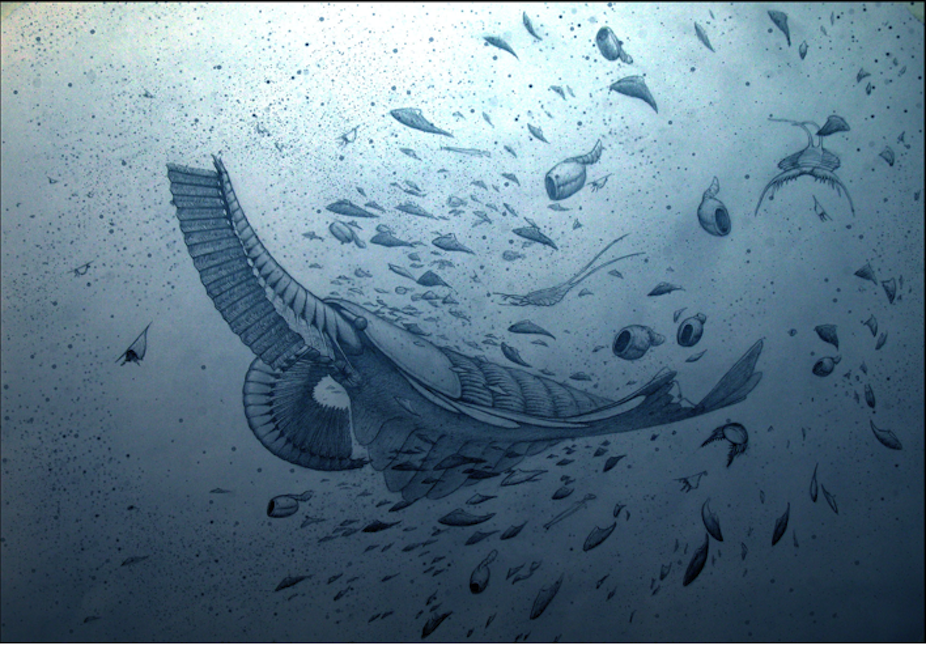In a recent paper in Nature, we described a strange marine animal, called Tamisiocaris. They were giants that swam in the oceans over 500 million years ago. They had strange looking appendages on their faces, which filtered food from the ocean, according to new fossil evidence found in Greenland.
Such discoveries are being made at three sites around the world. And they are all from a key event in the history of our planet called the Cambrian Explosion.
Within a relatively short space of geological time, some 520 to 505 million years ago, a spectacular variety of entirely new animals evolved, rapidly participating in some of the first complex marine communities. This was a time of great evolutionary experimentation, when chance and contingency were critical parts of the story.
Carnival time
The first discovered carnival of animals on Earth is preserved in the Burgess Shale, high in the Canadian Rockies. The fossils at the site became the focus of intense research for nearly a century, telling us a great deal about how life on earth evolved.
Then a locality was discovered in the early 1980s in southern China, which too seem to preserve similar fossils. They have already revealed hundreds of new forms, indicating the fauna is every bit as diverse as that from the Rockies.
The locality in the Sirius Pass in North Greenland is probably the oldest, least well known and most remote of the all the important regions that hold exceptionally-preserved Cambrian fossils. The area was discovered by chance in 1984 by a group of field geologists mapping the region for the Geological Survey of Greenland.

It was quickly realised that here too were fossils comparable to those from the Burgess Shale but probably older and therefore closer to the first major explosion of animal life on Earth. A number of expeditions in the later 1980s and early 1990s began to assemble collections of fossil material, but the fossils were only recovered from the scree slopes of the mountain exposure of the Buen Shales and were not always well preserved.
Sirius shining
I led a new expedition in 2009, which successfully located the rock exposures yielding the fossils and a second in 2011 continued the quest to build up a new collection. Over 50 species are now known from the Sirius Pass, many new to science.
The fossils are some of the earliest representatives of all the living animal species we see today. Superficially they look familiar but are not quite right. For example, the large Arthroaspis is an early arthropod, exceptionally preserved, displaying all manner of its anatomy.
New material of the giant early marine animal called Tamisiocaris, recently published in Nature, suggests that rather than being a top predator in the ecosystem, it was a sweep-net feeder. Using this feeder, it would swim along, trapping plankton rather like Baleen whales today.
The fact that large, free-swimming suspension feeders roamed the oceans tells us a lot about the ecosystem. Feeding on the smallest particles by filtering them out of the water while actively swimming around requires a lot of energy – and therefore lots of food. This suggests that the food chain was much more complex than we had previously envisaged and there was clearly an abundance of food and nutrients in these ancient Cambrian oceans.

There are many more weird animals. The vetulicolian Oedigera resembles a large tadpole with gills with a paddle-like tail. Exactly what present-day species it relates to is still uncertain. Some have assigned it to the arthropods (to which crabs belong), others to the stem of the vertebrate tree (to which humans belong) but most probably it was a common ancestor of the chordates and echinoderms (to which starfish belong).
Even stranger, Sirilorica resembles a large, plated space capsule reaching 10cm in length. Modern relatives, the loriciferans are microscopic forms. Finally two lobopods, related to modern velvet worms, Kerygmachela and Pambdelurion, were relatively large marine predators with expansive frontal appendages extending forwards from their heads.
These fossils give us a unique insight into the first animal-based communities on our planet, the types of animals that inhabited this first complex ecosystem and how they interacted with each other and their environment. The Sirius Pass is proving to be a real treasure trove and there is no doubt many more bizarre and spectacular fossils await discovery in these beautiful Arctic wastes.

